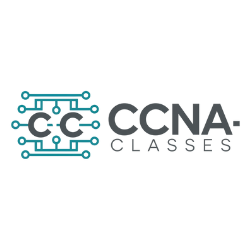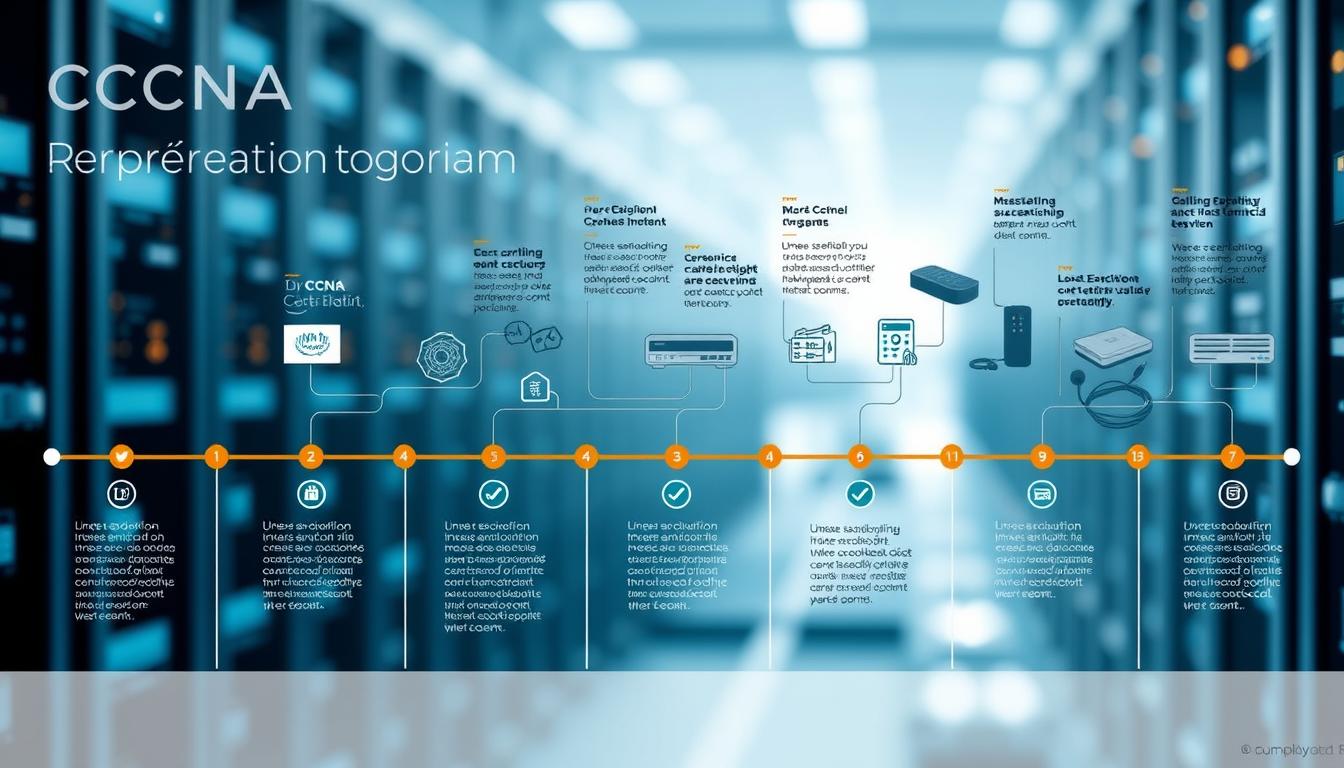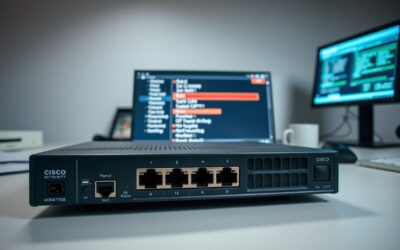You’re probably wondering how much time you’ll need to dedicate to earn your Cisco certification. The answer? Most learners spend 3–5 months preparing, but your journey depends on your background and study habits. Let’s break down what you need to know to plan effectively.
Imagine this: You’re setting up your first virtual lab late at night, coffee in hand, determined to master subnetting. That’s where many start. The 200-301 exam covers everything from network security to IP connectivity, and how you learn these skills matters as much as how long it takes. Recent surveys show 50% of test-takers spend 6 weeks to 5 months preparing, while those with hands-on experience often move faster.
This guide will walk you through realistic timelines, proven study strategies, and how to balance labs with theory. Whether you’re juggling a job or diving in full-time, you’ll find actionable steps to build confidence—and avoid burnout.
Key Takeaways
- Most people prepare for the Cisco certification in 3–5 months, depending on prior experience.
- The exam tests practical skills like configuring networks and troubleshooting security issues.
- Virtual labs and practice tests significantly improve preparation efficiency.
- Certification remains valid for three years, with flexible recertification options.
- Over 65% of successful candidates blend structured courses with self-paced learning.
Understanding CCNA Certification and Training Basics
Think of your career path like building a house. You need solid groundwork before adding walls. That’s what this credential offers—a proven way to validate your ability to manage modern infrastructure. Since 1998, it’s helped over 1 million professionals launch tech careers.
From Networking Basics to Industry Standard
The program has evolved dramatically. Originally focused on routers and switches, the 2020 update added security and automation. Today, 42% of certified professionals report solving tech issues faster than peers, according to IDC research.
Why does this matter? Employers trust the credential because it tests real-world scenarios. You’ll configure virtual networks, troubleshoot connections, and secure data—exactly what businesses need. Recent job postings show 68% of network admin roles list it as preferred or required.
What You’ll Need to Succeed
To earn your badge, you’ll tackle the 200-301 test. It’s a 120-minute challenge covering six key areas:
| Exam Section | Weight | Key Skills |
|---|---|---|
| Network Access | 20% | VLANs, wireless setups |
| Security Basics | 15% | Threat prevention |
| Automation | 10% | Scripting fundamentals |
The $300 exam fee includes free retakes after five days if needed. Most first-timers spend 6-10 weeks preparing. “It forced me to think like a network engineer,” says Maria Chen, who doubled her salary after certification.
Your credential stays active for three years. Renew it by taking updated tests or earning higher-level certs. Ready to map out your study strategy? Let’s explore proven methods next.
Practical Preparation Strategies for Exam Success
Picture this: Your desk glows with laptop light at 7 PM as you sketch out next week’s study blocks. That’s where victory begins—not just memorizing facts, but crafting habits that turn concepts into muscle memory. Industry surveys reveal 63% of successful candidates use structured plans blending theory with hands-on practice.
Building Momentum Through Micro-Goals
Start by dividing your 5-month journey into phases. Week 1-6: Master network fundamentals. Month 2: Dive into security protocols. One Cisco Learning Network member shared, “I treated each subnetting drill like a puzzle—celebrating with coffee after solving 10 problems.”
Try this sample schedule:
| Phase | Focus | Tools |
|---|---|---|
| Weeks 1-4 | Network basics | Official Cert Guide |
| Month 2 | Security labs | Packet Tracer |
| Month 5 | Full-length exams | Boson ExSim |
Simulate Real-World Pressure
Virtual labs transform abstract ideas into tangible skills. When Jamal, a recent test-taker, configured his first VLAN, he realized “the click-clack of keyboard shortcuts became my rhythm.” CBT Nuggets recommends dedicating 40% of study time to labs—like troubleshooting DHCP issues or setting up OSPF.
Practice exams reveal hidden gaps. One learner discovered they’d misconfigured IPv6 routes seven times before getting it right. Schedule mock tests every 3 weeks—review wrong answers, then attack those topics.
Reward small wins. Finished a lab? Watch an episode of your favorite show. Nailed a quiz? Treat yourself to a walk. These moments keep motivation fresh, turning marathon prep into achievable sprints.
Delving into Network Fundamentals and Real-World Applications
Remember that moment when textbook diagrams suddenly click as you configure your first router? That’s where theory meets practice. Mastering concepts like subnetting or VLANs isn’t just about passing an exam—it’s about solving actual network puzzles you’ll face on the job.

From Concepts to Console Commands
Start by tackling TCP/IP layers and IPv4 addressing. These form the backbone of modern networks. Cisco’s Packet Tracer lets you build virtual networks where mistakes become lessons. One learner shared, “I finally understood OSPF routing after seeing traffic flow in real-time during a lab.”
Try this approach:
| Concept | Real-World Use | Tool |
|---|---|---|
| VLAN Configuration | Segment office departments securely | Cisco IOS |
| Access Control Lists | Block unauthorized traffic | Wireshark |
| DHCP Setup | Automate IP assignments | Packet Tracer |
Hands-on practice builds muscle memory. When troubleshooting a simulated network outage, you’ll learn faster than reading manuals. Recent graduates report 30% higher retention rates when combining video courses with labs.
Pro tip: Recreate common issues like DNS failures or rogue devices. These exercises mirror real troubleshooting scenarios. As you master these skills, you’ll naturally transition to discussing industry trends—like how automation shapes modern networks.
CCNA Training Duration: Tips, Trends, and Real-World Experiences
Ever wonder why some people breeze through their studies while others need extra months? The secret often lies in their background. A recent LinkedIn survey shows 53% of test-takers finish prep in 6 weeks to 5 months—but those with hands-on network experience typically shave 30% off that timeline.

Industry Statistics and Survey Insights on Study Time
CBT Nuggets analyzed 1,200 learners and found a clear pattern:
| Group | Average Prep Time | Pass Rate |
|---|---|---|
| New to Networking | 4.5 months | 72% |
| 1+ Year Experience | 3.1 months | 89% |
Twitter polls reveal why: 68% of professionals say configuring routers daily helps them grasp concepts faster. “I recognized VLAN scenarios from work,” shares IT specialist Derek Mills, who passed in 11 weeks.
How Work Experience Can Shorten Your Preparation Time
Your job might be your best study buddy. Troubleshooting real switches teaches you more than any textbook. Focus on areas where you’re weakest—maybe automation scripts or security protocols—instead of starting from scratch.
Try these time-savers:
- Map lab exercises to tasks you do at work
- Use lunch breaks for 15-minute practice tests
- Join study groups with colleagues
As you move toward the finish line, remember: Your unique background shapes your path. Customize your plan, lean on what you know, and watch those study hours become more effective every week.
Conclusion
Ready to turn your study plan into career momentum? Whether you’re configuring VLANs or troubleshooting security protocols, success hinges on personalized preparation. Most learners thrive with 3–5 months of focused practice—those with hands-on experience often reach goals faster.
Build your strategy around what works for you. Mix virtual labs like Cisco Packet Tracer with timed practice tests to sharpen real-world skills. Remember, 89% of professionals with network experience pass quicker by aligning study sessions with daily tasks.
Keep these tips handy:
• Schedule weekly lab sessions to reinforce concepts
• Renew your credential every three years through Cisco’s flexible options
• Join communities like CBT Nuggets forums for peer support
Your journey doesn’t end at the exam. Stay curious about automation trends and emerging technologies. Share your progress with colleagues—their insights might unlock your next breakthrough.
Now’s the time to act. Open that virtual lab, bookmark Cisco’s official resources, and start building the expertise employers value. Every command you master today becomes tomorrow’s career advantage.
FAQ
How has the Cisco Certified Network Associate evolved to stay relevant?
What’s required to earn the certification?
Can a five-month study plan prepare me adequately?
How do virtual labs improve exam readiness?
Why is hands-on experience critical for mastering network fundamentals?
Does prior IT work shorten preparation time?
What’s the average study time based on recent surveys?
Source Links
- Here’s How Long You’ll Want to Study for the CCNA
- What Is the CCNA? An Entry-Level Networking Certification
- Everything you need to know about the CCNA certification | Cisco Certified Network Associate
- CCNA Training Session Summary
- 5 Study Tips to Pass the CCNA Certification Exam
- Mastering the CCNA Certification Exam in 2024
- Cisco CCNA Prep
- Cisco CCNA Bootcamp – CCNA 200-301 Bootcamp
- CCNA Online training Course & Certification
- New CCNA v1.1 Updates: Preparing for the 2024 CCNA v1.1 (200-301) Exam
- How Long to Study for CCNA? [2025 Exam Prep Guide]
- CCNA Course: What It Includes, Fees, Duration & How to Learn – Lakshya Institute of Networking Technologies





